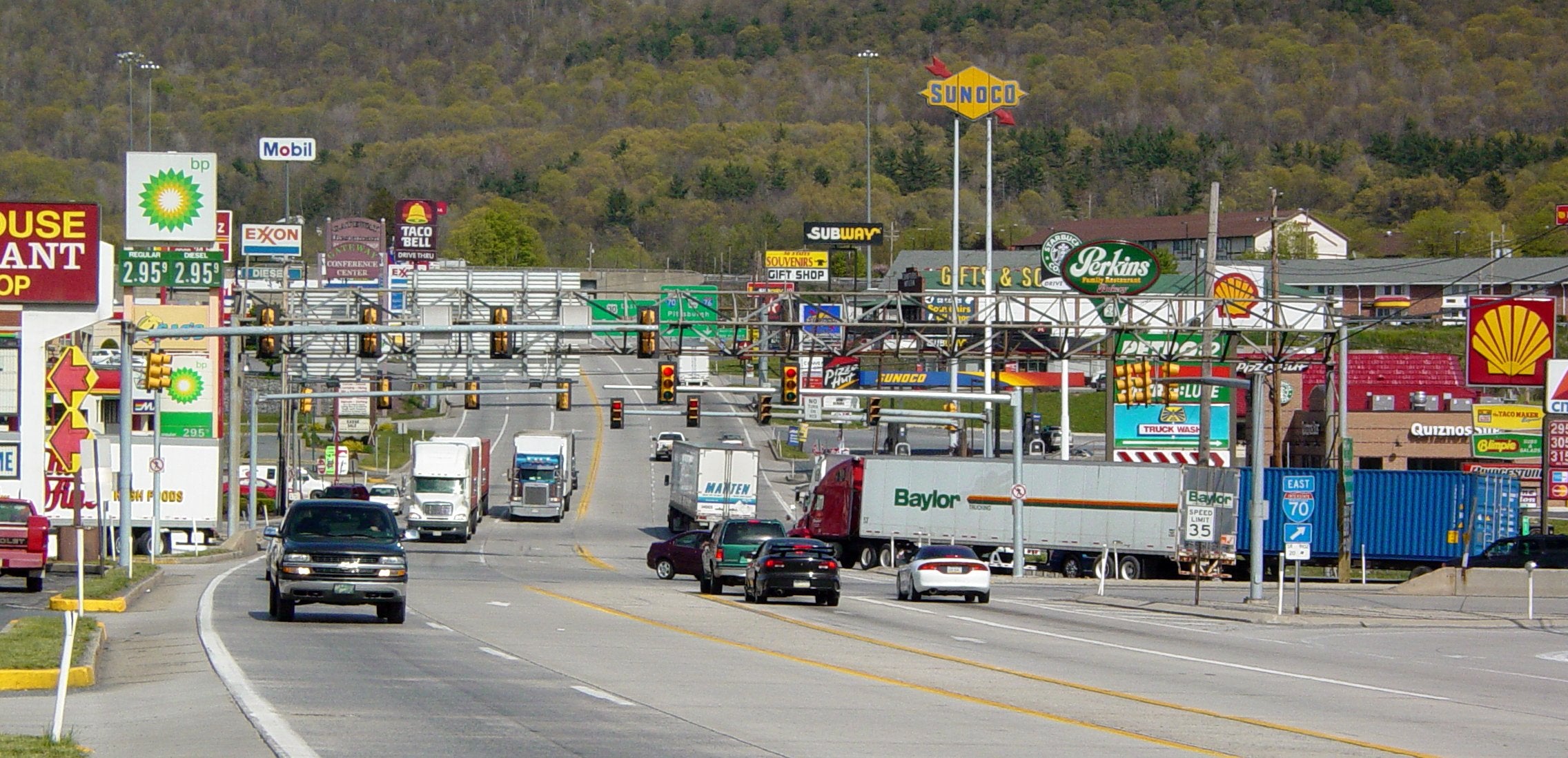Highway history: How the Pennsylvania Turnpike created and destroyed towns

Breezewood is one of the original exits on the Pennsylvania Turnpike. It's known as the "travelers' oasis." (Ben Schumin/Wikimedia Commons)
The Pennsylvania Turnpike turned 75 on Thursday. America’s first superhighway changed Pennsylvania’s landscape significantly.
Breezewood, Pennsylvania has been called the “town of motels,” the “travelers’ oasis,” and, most colorfully, “an Emerald City to the Pennsylvania Turnpike’s yellow brick road.” Most people greet this town-turned-rest-stop after driving through the spectacular beauty of Pennsylvania’s mountains, and it’s a jarring sight. There are gas stations, truck stops, hotels, motels and a single church. The town exists to serve motorists.
Breezewood is a creation of the Pennsylvania Turnpike, which turns 75 this week. The Turnpike was the first superhighway in the country, America’s answer to the Autobahn, and quite the tourist attraction.
“It seems crazy that people would just drive on the highway as an activity,” says Curt Miner, senior history curator at the Pennsylvania State Museum. “But we would, my family would just get in the car, drive the Turnpike and stop at rest stops in between.”
America’s Autobahn
“When it was built, the Turnpike was like the eighth wonder of the world,” says Miner. “The country had never seen anything like it before.”
Before the road was created, driving from Pittsburgh to Harrisburg took seven hours, passing through small towns and many traffic lights along the way. Like those in the rest of the country, highways in Pennsylvania were two lanes, poorly paved and went steeply over mountains. The Turnpike was the antidote to all of that.
It had four lanes, two going in each direction. It went through tunnels in the mountains, rather than over them. And it had exits, with toll booths, rather than stoplights.
A history of the Turnpike, written by the Federal Highway Administration, quotes Harry Lundy, one of the engineers on the project: “Nobody had ever seen a road without stoplights, intersections, steep hills and sharp curves.”
Turnpike towns
But the wildly popular superhighway had a “devastating impact” on some small towns in Pennsylvania, according to Olga Herbert, the executive director of the Lincoln Highway Heritage Corridor. Before the Turnpike, there was Route 30, also called the Lincoln Highway. Towns along that road weren’t overjoyed by a new highway that went through the mountains, cutting them off completely.
“When I go to these towns, I say, look at how many banks you had! Look at how many dance halls, how many restaurants and hotels you had,” says Herbert. “They say, now, we just have one ATM machine. They can’t believe it.”
She gives the example of McConnellsburg, the county seat of Fulton County. In 1924, the town had four hotels, two banks, two newspapers and 25 businesses serving drivers on the Lincoln Highway. Today, you have to leave the Turnpike and drive up the antiquated mountain roads of the Lincoln Highway to get to town, where there are few businesses and no hotels.
With people unwilling to drive over the mountains, on a narrow two-lane road with sharp curves and stoplights, when they could take a straight-shot through the mountains, Herbert says many towns effectively disappeared.
“Those towns just dried up and died,” says Herbert.
One of the Lincoln Highway towns, Everett, declined an exit on the Turnpike, according to Gillian Leach of the Bedford County Historical Society. Many people in Everett and other towns were betting against this superhighway.
But that decision proved to be a mistake.
The towns of Bedford and Breezewood, on either side of Everett, feel the positive effects of having a Turnpike exit in their area.
“Because of the Turnpike, we’ve been able to establish strong distribution centers,” says Bette Slayton, of the Bedford County Development Association. “We have the only REI distribution center on the East Coast. When they looked all over the East Coast, they chose us because of that access to the Turnpike and, now, I-99.”
She says they have trucking companies that locate in the county, and they capitalize on Turnpike tourism when people get off the road to come see downtown Bedford. Sunday afternoon drives with a stop at a Howard Johnson’s may be a relic of the past, but the Turnpike is still good for business in Bedford.
Turnpike today
On the day that the Pennsylvania Turnpike opened, a brochure was handed out with this quote from the chair of the Pennsylvania Turnpike Commission, Walter Jones: “Many, undoubtedly, will decry any proposed network [of highways] as being too ambitious and impractical for our day. History will answer such doubts with this admonition: ‘You can’t stand in the way of progress.'”
From the view of 75 years out, was the Turnpike a success? When it opened in 1940, tolls were supposed to be a temporary measure until the road was paid for in about a decade. Today, the Turnpike is facing nearly $10 billion of debt as tolls go to pay for other PennDOT projects. The Turnpike Commission has been plagued with corruption scandals and there has been talk of leasing the highway to keep it afloat. For now, the plan is to raise toll rates until a more sustainable idea emerges.
It’s easy to get frustrated with the rising tolls, traffic and construction that comes with the Turnpike. But pull into Breezewood any hour of the day or night: the lights are on, the gas is pumping and the hotel business is robust. It’s not just a highway, it’s an economic engine.
WHYY is your source for fact-based, in-depth journalism and information. As a nonprofit organization, we rely on financial support from readers like you. Please give today.


